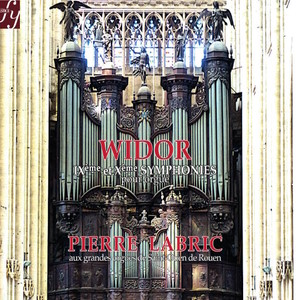
Charles-Marie Widor (1844-1937)
Neuvième Symphonie pour orgue “Gothique” Op. 70 (1895)
Dixième Symphonie pour orgue “Romane” Op. 73 (1899)
Pierre Labric (organ)
rec. 6-7 July 1971, Saint-Ouen Abbey, Rouen, France
Solstice SOCD400 [62]
Pierre Labric may be best recalled today for his cycles of the organ symphonies of Charles-Marie Widor and Louis Vierne. He recorded them in 1969-1974 on the stunning Cavaillé-Coll organ in the church at Abbaye Saint-Ouen de Rouen. The booklet gives no biographical details. Briefly: he was born in Rouen in 1921, studied at the local conservatory with the French composer, organist and conductor Marcel Lanquetuit, and then he went to the Paris Conservatoire. He studied organ with Marcel Dupré and harmony with Maurice Duruflé. He was assistant to Jeanne Demessieux at La Madeleine in Paris, and then to Pierre Cochereau at the Notre Dame Cathedral. Aside from Widor and Vierne, Labric has made essential recordings of Demessieux, Eugène Reuchsel and Liszt.
This is the second instalment of Widor’s cycle. Symphonies Nos. 5 and 6 were issued in 2022 to celebrate Pierre Labric’s 101st birthday (review). The Solstice website says that their aim was to “rescue the recorded legacy of Pierre Labric from oblivion”. The release of Widor’s symphonies in the United States by the Musical Heritage Society suffered from a “mediocre pressing”. Fortunately, a “miracle happened”. The booklet says that aware “of our problems, a Rouen doctor informed us that he had just acquired at auction (!) a fair number of tapes from the original collection”.
I have used the nomenclature of each work as given in the liner notes. There are others in use.
By and large, the first eight of Widor’s organ symphonies are secular, but when he composed the Gothique and the Romane, he looked to plainchant for an inspiration. Both works took on a sacred or mystical character.
Neuvième Symphonie pour orgue “Gothique” was dedicated to the Church of Saint-Ouen in Rouen. Organ enthusiasts will know that the Cavaillé-Coll instrument there is regarded as one of the most superb the renowned company ever built. The opening Moderato seeks calm from the first note to the last, and rarely finds it. This is truly tormented music. It has been suggested that this movement “depicts the severe imposing facade of the basilica”. There follows the contrasting and prayerful Andante sostenuto with its labyrinth-like twisting melody. Plainsong appears in the Allegro third movement: the Christmas introit Puer natus est (A Boy is Born) introduced on the pedals. The movement is essentially a fugue alla gigue. The finale, another Moderato, has been likened to a historical trip through organ music history (past, present and even, perhaps, the future); it culminates in a ‘toccata’ that is fairly and squarely Widor’s own. Interestingly, the movement ends quietly. It is an effective set of variations.
Dixième Symphonie pour orgue “Romane” features two plainsong chants. The Easter Sunday Gradual Haec dies (This is the Day) appears in the first, second and fourth movement, Moderato, Choral and Final respectively. Cantilène, the slow melancholic third movement, contains part of the Easter Sequence Victimae paschali laudes. The Symphonie, completed in Lyon, was once again dedicated to a building: the Basilica of Saint-Sernin in Toulouse, a large Romanesque church, complete with a Cavaillé-Coll organ also regarded as one of the finest in France.
Albert Schweitzer once wrote: “When one Sunday (in 1900) still striving with technical problems, [Widor] played for the first time in St. Suplice the Symphonie Romane, I felt with him that in this work the French art of organ playing had entered sacred art.” It could be construed that the entire Symphonie is a set of variations on the Gradual for Easter Sunday, Haec dies quam fectit Dominus (This is the day which the Lord hath made). Certainly, the diverse musical material that Widor builds from his “theme” is impressive. There are some complex Lisztian figurations and chromaticism that contrast with modal melodies and harmonies. The final movement is interesting with its huge climaxes and long decrescendo to the quiet ending. It is a forgotten warhorse.
The liner notes (in French and English) give a detailed exposition of these two massive organ symphonies. This is preceded by an overview of Widor’s life and achievement. The all-important specification of the organ is included. This magnificent instrument, installed in 1890, was one of the last to be built under the supervision of Aristide Cavaillé-Coll. It has remained almost intact, with only some restoration work carried out in 1941 and 1955. As noted, the booklet gives no biographical details about Pierre Labric.
The superb recording reveals no suggestion of the above-mentioned “mediocre pressings”, although I felt that some of the passages were a little bright in places. But typically, the Rouen Cavaillé-Coll instrument is heard in all its glory. I find Pierre Labric’s recital satisfying, inspiring, and moving throughout. I look forward to subsequent issues in this series.
John France
Availability: Solstice Music


















